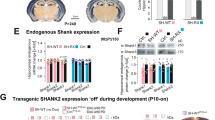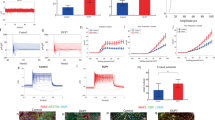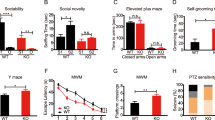Abstract
Autism spectrum disorder (ASD) is a neurodevelopmental disorder of unknown cause, although one hypothesis suggests a potential imbalance between excitation and inhibition that leads to changes in neuronal activity and a disturbance in the brain network. However, the mechanisms through which neuronal activity contributes to the development of ASD remain largely unexplained. In this study, we described that neuronal activity at the transcriptional and translational levels regulated the expression of Auts2 isoforms. The prolonged stimulation of cultured cortical neurons significantly reduced the auts2 transcripts, accompanied by the decrease of FL-Auts2 protein, as well as one of the short isoforms (S-Auts2 var.1). Blocking neuronal activity increased the number of auts2 transcripts but not protein levels. Furthermore, blocking the NMDA receptors during stimulation could partially restore the FL-Auts2 and S-Auts2 var.1 at protein level, but not at mRNA level. Finally, Auts2 expression in the hippocampus was reduced in mice exposed to an enriched environment, a behavior paradigm designed to increase the brain activity through abundant sensory and social stimulations. Thus, our study revealed a novel regulatory effect of neuronal activity on the transcription and translation of ASD-risk gene auts2.







Similar content being viewed by others
Availability of Data and Materials
The datasets used during current study are available from the corresponding author on reasonable request.
References
Lord C, Charman T, Havdahl A, Carbone P, Anagnostou E, Boyd B et al (2022) The Lancet Commission on the future of care and clinical research in autism [J]. Lancet 399(10321):271–334
Association AP (2015) Neurodevelopmental disorders: DSM-5® selections. American Psychiatric Pub
Rubenstein JL, Merzenich MM (2003) Model of autism: increased ratio of excitation/inhibition in key neural systems [J]. Genes Brain Behav 2(5):255–267
Nelson SB, Valakh V (2015) Excitatory/inhibitory balance and circuit homeostasis in autism spectrum disorders [J]. Neuron 87(4):684–698
Yizhar O, Fenno LE, Prigge M, Schneider F, Davidson TJ, O’Shea DJ et al (2011) Neocortical excitation/inhibition balance in information processing and social dysfunction [J]. Nature 477(7363):171–178
Chao HT, Chen H, Samaco RC, Xue M, Chahrour M, Yoo J et al (2010) Dysfunction in GABA signalling mediates autism-like stereotypies and Rett syndrome phenotypes [J]. Nature 468(7321):263–269
Peixoto RT, Wang W, Croney DM, Kozorovitskiy Y, Sabatini BL (2016) Early hyperactivity and precocious maturation of corticostriatal circuits in Shank3B(-/-) mice [J]. Nat Neurosci 19(5):716–724
Gibson JR, Bartley AF, Hays SA, Huber KM (2008) Imbalance of neocortical excitation and inhibition and altered UP states reflect network hyperexcitability in the mouse model of fragile X syndrome [J]. J Neurophysiol 100(5):2615–2626
Selimbeyoglu A, Kim CK, Inoue M, Lee SY, Hong ASO, Kauvar I et al (2017) Modulation of prefrontal cortex excitation/inhibition balance rescues social behavior in CNTNAP2-deficient mice [J]. Sci Transl Med 9(401)
Antoine MW, Langberg T, Schnepel P, Feldman DE (2019) Increased excitation-inhibition ratio stabilizes synapse and circuit excitability in four autism mouse models [J]. Neuron 101(4):648–61.e4
Bateup HS, Johnson CA, Denefrio CL, Saulnier JL, Kornacker K, Sabatini BL (2013) Excitatory/inhibitory synaptic imbalance leads to hippocampal hyperexcitability in mouse models of tuberous sclerosis [J]. Neuron 78(3):510–522
Pinto D, Pagnamenta AT, Klei L, Anney R, Merico D, Regan R et al (2010) Functional impact of global rare copy number variation in autism spectrum disorders [J]. Nature 466(7304):368–372
Martinowich K, Hattori D, Wu H, Fouse S, He F, Hu Y et al (2003) DNA methylation-related chromatin remodeling in activity-dependent BDNF gene regulation [J]. Science 302(5646):890–893
Chen WG, Chang Q, Lin Y, Meissner A, West AE, Griffith EC et al (2003) Derepression of BDNF transcription involves calcium-dependent phosphorylation of MeCP2 [J]. Science 302(5646):885–889
Bloodgood BL, Sharma N, Browne HA, Trepman AZ, Greenberg ME (2013) The activity-dependent transcription factor NPAS4 regulates domain-specific inhibition [J]. Nature 503(7474):121–125
Beunders G, Voorhoeve E, Golzio C, Pardo LM, Rosenfeld JA, Talkowski ME et al (2013) Exonic deletions in AUTS2 cause a syndromic form of intellectual disability and suggest a critical role for the C terminus [J]. Am J Hum Genet 92(2):210–220
Kalscheuer VM, FitzPatrick D, Tommerup N, Bugge M, Niebuhr E, Neumann LM et al (2007) Mutations in autism susceptibility candidate 2 (AUTS2) in patients with mental retardation [J]. Hum Genet 121(3–4):501–509
Jolley A, Corbett M, McGregor L, Waters W, Brown S, Nicholl J et al (2013) De novo intragenic deletion of the autism susceptibility candidate 2 (AUTS2) gene in a patient with developmental delay: a case report and literature review [J]. Am J Med Genet A. 161a(6):1508–12
Oksenberg N, Ahituv N (2013) The role of AUTS2 in neurodevelopment and human evolution [J]. Trends Genet 29(10):600–608
Monderer-Rothkoff G, Tal N, Risman M, Shani O, Nissim-Rafinia M, Malki-Feldman L et al (2021) AUTS2 isoforms control neuronal differentiation [J]. Mol Psychiatry 26(2):666–681
Hori K, Nagai T, Shan W, Sakamoto A, Taya S, Hashimoto R et al (2014) Cytoskeletal regulation by AUTS2 in neuronal migration and neuritogenesis [J]. Cell Rep 9(6):2166–2179
Hori K, Yamashiro K, Nagai T, Shan W, Egusa SF, Shimaoka K et al (2020) AUTS2 regulation of synapses for proper synaptic inputs and social communication [J]. iScience. 23(6):101183
Bedogni F, Hodge RD, Nelson BR, Frederick EA, Shiba N, Daza RA et al (2010) Autism susceptibility candidate 2 (Auts2) encodes a nuclear protein expressed in developing brain regions implicated in autism neuropathology [J]. Gene Expr Patterns 10(1):9–15
Gao Z, Lee P, Stafford JM, von Schimmelmann M, Schaefer A, Reinberg D (2014) An AUTS2-Polycomb complex activates gene expression in the CNS [J]. Nature 516(7531):349–354
Oksenberg N, Stevison L, Wall JD, Ahituv N (2013) Function and regulation of AUTS2, a gene implicated in autism and human evolution [J]. PLoS Genet 9(1):e1003221
Li J, Sun X, You Y, Li Q, Wei C, Zhao L et al (2022) Auts2 deletion involves in DG hypoplasia and social recognition deficit: the developmental and neural circuit mechanisms [J]. Sci Adv. 8(9):eabk1238
Yamashiro K, Hori K, Lai ESK, Aoki R, Shimaoka K, Arimura N et al (2020) AUTS2 governs cerebellar development, Purkinje cell maturation, motor function and social communication [J]. iScience. 23(12):101820
Schaukowitch K, Reese AL, Kim SK, Kilaru G, Joo JY, Kavalali ET et al (2017) An intrinsic transcriptional program underlying synaptic scaling during activity suppression [J]. Cell Rep 18(6):1512–1526
West AE, Greenberg ME (2011) Neuronal activity-regulated gene transcription in synapse development and cognitive function [J]. Cold Spring Harb Perspect Biol. 3(6):a005744
Flavell SW, Greenberg ME (2008) Signaling mechanisms linking neuronal activity to gene expression and plasticity of the nervous system [J]. Annu Rev Neurosci 31:563–590
Yap EL, Greenberg ME (2018) Activity-regulated transcription: bridging the gap between neural activity and behavior [J]. Neuron 100(2):330–348
Pang W, Yi X, Li L, Liu L, Xiang W, Xiao L (2021) Untangle the multi-facet functions of Auts2 as an entry point to understand neurodevelopmental disorders [J]. Front Psychiatry 12:580433
Ameur A, Zaghlool A, Halvardson J et al (2011) Total RNA sequencing reveals nascent transcription and widespread co-transcriptional splicing in the human brain [J]. Nat Struct Mol Biol 18(12):1435–1440
Wu CH, Tatavarty V, Jean Beltran PM et al (2022) A bidirectional switch in the Shank3 phosphorylation state biases synapses toward up- or downscaling [J]. Elife 26(11):e74277
Djakovic SN, Schwarz LA, Barylko B et al (2009) Regulation of the proteasome by neuronal activity and calcium/calmodulin-dependent protein kinase II [J]. J Biol Chem 284(39):26655–26665
Ramachandran KV, Fu JM, Schaffer TB et al (2018) Activity-dependent degradation of the nascentome by the neuronal membrane proteasome [J]. Mol Cell 71(1):169-177.e6
Lord C, Elsabbagh M, Baird G, Veenstra-Vanderweele J (2018) Autism spectrum disorder [J]. Lancet 392(10146):508–520
Mauger O, Lemoine F, Scheiffele P (2016) Targeted intron retention and excision for rapid gene regulation in response to neuronal activity [J]. Neuron 92(6):1266–1278
Kao SH, Wang WL, Chen CY et al (2015) Analysis of protein stability by the cycloheximide chase assay [J]. Bio Protoc 5(1):e1374
Nanki K, Toshimitsu K, Takano A, Fujii M, Shimokawa M, Ohta Y et al (2018) Divergent routes toward Wnt and R-spondin niche independency during human gastric carcinogenesis [J]. Cell 174(4):856–69.e17
Yang Y, Willis TL, Button RW, Strang CJ, Fu Y, Wen X et al (2019) Cytoplasmic DAXX drives SQSTM1/p62 phase condensation to activate Nrf2-mediated stress response [J]. Nat Commun 10(1):3759
Heim JB, Squirewell EJ, Neu A, Zocher G, Sominidi-Damodaran S, Wyles SP et al (2017) Myosin-1E interacts with FAK proline-rich region 1 to induce fibronectin-type matrix [J]. Proc Natl Acad Sci U S A 114(15):3933–3938
Acknowledgements
We thank Dr. Feng Shi and Dr. Wen Shilei for kind suggestions to our manuscript and experimental techniques.
Funding
This study is supported by the National Natural Science Foundation of China (31960170) and the Hainan Province Science and Technology Special Fund (ZDYF2020216) to L.X., the Hainan Province Science and Technology Special Fund (ZDYF2021SHFZ088) and Hainan Major Science and Technology Projects (ZDKJ2019010) to W.X., the Natural Science Foundation of Hainan Province (821QN1001) to W.B.P., and the Hainan Graduate Students Innovation Projects (Qhys2021-357) to M.J.W. and (Qhys2021-355) to Q.S.B.. The study also received financial support from the Hainan Province Clinical Medical Center Grant (QWYH202175) and the Excellent Talent Team of Hainan Province (QRCBT202121).
Author information
Authors and Affiliations
Contributions
L.X. and W.X. designed the study. L.X., W.X., and W.B.P. wrote the paper. W.B.P. and M.J.W. performed most of the experiments, including neuronal culture, qPCR, Wes Assay, and enriched environmental paradigm. Q.S.B., H.A.L., and Q.L.Z. participated in the neuronal culture experiments. X.S.Y. helped with the qPCR experiments. All authors contributed to the article and approved the submitted version.
Corresponding authors
Ethics declarations
Ethics Approval
All animal experiments were performed according to the Ethics Committee of Hainan Medical University (HYLL-2022–259) and conformed to the ethical principles of welfare of laboratory animals.
Consent to Participate
This study did not involve human subjects.
Consent for Publication
This study did not involve patients.
Competing Interests
The authors declare no competing interests.
Additional information
Publisher's Note
Springer Nature remains neutral with regard to jurisdictional claims in published maps and institutional affiliations.
Wenbin Pang and Meijuan Wang are the co-first author.
Supplementary Information
Below is the link to the electronic supplementary material.

Supplementary Figure 1.
Representative amplification curves and agarose gel image of auts2 qPCR products. A. Representative amplification curves from qPCR experiments of auts2 transcripts. RFU, Relative fluorescence units. B. A representative agarose gel image of auts2 qPCR products. Predicted band sizes: FL-auts2: 165 bp; Total auts2: 107 bp; GAPDH: 183 bp. (PNG 57 kb)

Supplementary Figure 2.
The expression of c-fos after various durations of KCl stimulation. A. Level of c-fos transcripts in cultured neurons, with or without KCl incubation of 2 h, 6 h and 12 h. Each symbol represents one biological replicate (n=7). ***p<0.001, *p<0.05. The p-values were determined by two-way ANOVA and Sidak’s multiple comparisons test. B. The c-fos mRNA level with or without KCl incubation for the indicated durations. C-E. Level of c-fos proteins in cultured neurons, with or without KCl incubation for 2 h (C), 6 h (D) and 12 h (E), detected by Wes Assay. Upper panels: Example images of Wes Assay. Lower panels: Quantitative analysis. F. Level of c-fos proteins with or without KCl incubation for the indicated durations. Data are represented as mean ± SD. Each symbol represents one biological replicate (n=5). ***p<0.001, *p<0.05. The p-values were determined by unpaired student’s t test. (PNG 161 kb)

Supplementary Figure 3.
The level of Auts2 transcripts in the hippocampus and cortex after stimulation in vivo. A-C. Level of c-fos (A), FL-auts2 (B) and total auts2 (C) transcripts from the hippocampi (HP) of EE mice and SH mice. Each symbol represents one biological replicate (n=4 or 3). **p<0.01. The p-values were determined by unpaired student’s t test. D-F. Level of c-fos (D), FL-auts2 (E) and total auts2 (F) transcripts from the cortices (Cx) of EE mice and SH mice. One of the SH points was normalized to 1. Data are represented as mean ± SD. Each symbol represents one biological replicate (n=4 or 3). *p<0.05. The p-values were determined by unpaired student’s t test. (PNG 57.8 kb)
Rights and permissions
Springer Nature or its licensor (e.g. a society or other partner) holds exclusive rights to this article under a publishing agreement with the author(s) or other rightsholder(s); author self-archiving of the accepted manuscript version of this article is solely governed by the terms of such publishing agreement and applicable law.
About this article
Cite this article
Pang, W., Wang, M., Bi, Q. et al. Activity-Dependent Differential Regulation of Auts2 Isoforms In Vitro and In Vivo. Mol Neurobiol 60, 2973–2985 (2023). https://doi.org/10.1007/s12035-023-03241-x
Received:
Accepted:
Published:
Issue Date:
DOI: https://doi.org/10.1007/s12035-023-03241-x




